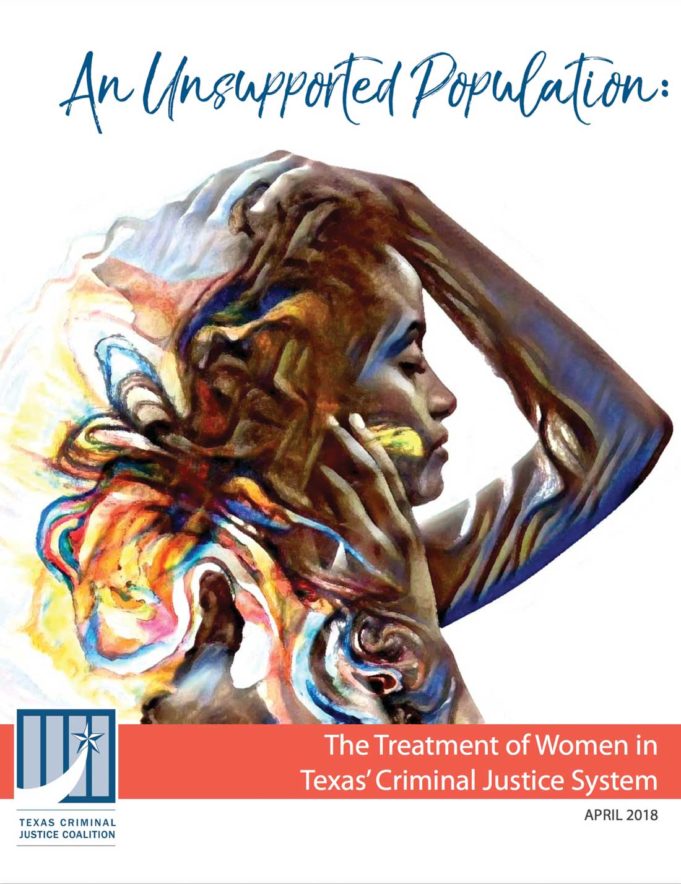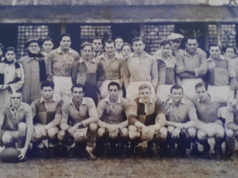While the number of women in the entire United States’ criminal justice system has ballooned since 1980, the number of women in Texas prisons has grown nearly 1,000 percent during that period, giving Texas the dubious distinction of incarcerating more women than any other state. Unfortunately, Texas has not kept up with the particular services that those women need, falling short on every level, from basic hygiene to safety to family contact to preparation for reentry into society.
There are now more than 12,500 women in Texas’ state jails and prisons — county jails are not included in that number because the population fluxuates so quickly — and most of the prisoners, or about two-thirds of them, are in for nonviolent crimes.
“People often point to incarceration as a way to make our communities safer,” said Lindsey Linder, a policy attorney with the Texas Criminal Justice Coalition, an Austin nonprofit that aims to transform the criminal justice system to support families and foster safer communities. “But anyone who thinks that incarcerating nonviolent women accomplishes community safety, well, I think they’re wrong.”
Linder is the author of two recent reports by the nonprofit that deal specifically with the issue of women in Texas’ prisons and state jails. “It is a failed system,” Linder said.
The twin reports highlight just how broken the system is, with little or no accounting for the poverty, trauma, and sexual abuse that drove the women to commit the crimes that led to prison or jail.
“We have a lack of community support,” Linder said, “and the result is that vulnerable populations get funneled into the criminal justice system. Folks who have mental health issues, who are poor or people of color, people with drug abuse issues — they get funneled into the system because of the failure of a mental health community infrastructure. A lot of the offenses that land these women in prison shouldn’t be considered crimes at all. These are public health issues, mostly. But while we, society, says we have no money for that mental health infrastructure, we pay on the back end by imprisoning those women, which is incredibly expensive for taxpayers.”
The first of the two reports, “A Growing Population: The Surge of Women into Texas’ Criminal Justice System,” deals with the sheer volume of women now in the system, their needs, and possible solutions that might slow the growth trend. The second report, “An Unsupported Population: The Treatment of Women in Texas’ Criminal Justice System,” details the inadequate support the women receive. The reports were compiled using survey answers from 438 women in Texas’ criminal justice system, augmented by interviews with dozens of women who had been released from prisons or state jail.
The picture they paint is harrowing: More than 81 percent of the women are mothers, and half of them never see their children while serving time. Very few see their children more than four times a year. Many of those visits are done via video cameras, so that the children aren’t able to hug their mothers for years at a time. Additionally, hundreds of pregnant women wind up in jail annually in Texas — most of their criminal behavior involves drug crimes, property offenses, or prostitution — and have their babies taken from them within a day of their birth. Simple things like tampons and sanitary pads are limited monthly, leaving women with heavy menstrual cycles to wear the same pads for hours or days at a time. Doctor visits frequently require a $100 copay, forcing many of the women to simply skip medical visits.
One of Linder’s sources, Lauren Johnson, is a former junkie who did three stints in prison, all of them related to drug use. “The second time I went to prison was just days after I found out I was pregnant with my first child,” she told me. “And I started imagining the kind of life I wanted for my kid, and I remember going to court and excitedly telling my attorney that I was pregnant. I thought that would help me, I guess, but he told me the State of Texas didn’t care if I was pregnant.”
Johnson got four years for that second offense but asked for and was granted a stay in the county jail until she had her baby. “I was in the Travis county jail for 10 months, and I got two full days with my son, Dylan, before I was sent to Plane State Jail in Dayton,” she said. “I was lucky. I had an aunt who took my baby until I got out.”
Johnson has been clean for several years, and with the exception of an arrest for a dirty needle during a relapse in 2010 that cost her eight months, she’s been free of the system as well. She began doing community organizing after her release — mainly fighting food stamp discrimination for people with felony convictions — and now works as a policy analyst for the American Civil Liberties Union. But her feelings from having been a mom while in prison remain strong.
“We are doing such generational harm by incarcerating these nonviolent women and otherwise nonviolent women imprisoned for domestic violence,” she said, referring to women jailed for allegedly retaliating against abusers. “We would be much better off having them in our communities, with their families, than locked up. We used to say, ‘Do the crime, do the time.’ Well, there used to be an end point to the time. Now you can’t get housing, can’t vote, can’t work. There is no end to the ‘time’ anymore, and that has to change.”
Tanya Halle’s story is difficult as well. She was in prison when diagnosed with breast cancer. “I got a six-year sentence for misappropriate use of funds from a tiny nonprofit I was working with,” she told me, “but they gave me probation as a first offense and a minor one. Unfortunately, I fell behind on the probation fees and wound up doing three and a half of those six years for that.”
While inside, she was a model prisoner, Halle said, and was given trusty status at a prison in Gatesville, the highest inmate status available. “And then I got diagnosed with breast cancer and was sent to a medical facility.”
In the following six months, she was given two rounds of chemotherapy, but instead of shrinking, her breasts swelled up. “I thought I might have inflammatory breast cancer, the worst kind, but the oncologist thought I just had a fungus,” Halle told me. “Well, it turned out I was right, and so they fought it with an aggressive radiation therapy for seven weeks daily. They wound up over-radiating me and burning me so badly I needed skin grafts.”
Unfortunately, the cancer metastasized to her left clavicle, which is now Stage IV cancer, which is being treated at the famed MD Anderson Cancer Center in Houston. Halle is still angry at the misdiagnosis of the original cancer and the subsequent radiation poisoning, but she’s also upset with the treatment the women receive on being released from prison.
“While I was inside, they’d tell me that when I got out I’d have all sorts of resources because of my cancer,” she said. “I wound up connecting with a church that found me a lady to stay with, but a week after I moved in, she told me I’d be charged more monthly than I could afford.”
Halle was rescued by a woman she’d met in prison, who worked as a volunteer with inmates and who let Halle move into her home. “You know, I got out of prison not knowing anything about Medicaid, not being able to work, not being able to find housing, with cancer, carrying the cloud of a felon,” Halle said. “It was overwhelming, but I was still the lucky one. I saw a lot of women with cancer in the medical unit, and all of them died inside.”
Linder said stories like Halle’s and Johnson’s make the women’s criminal justice system so important to her. “More than that,” she said, “it’s personal. When we look at the people in our lives, we realize that very little separates the women in the criminal justice system and them. Almost half of the women who answered the survey had been sexually molested as children. So was my mother. She sought comfort in relationships, in getting married and divorced a lot, moving around a lot, but if she’d chosen drugs as a coping mechanism rather than relationships, no doubt she would have been in prison. So you have a population that has suffered this complex trauma, and we’ve decided to criminalize these behaviors instead of addressing the causes of the issues.”
Alternatives to incarceration — included in the reports’ recommendations –– would be drug-diversion programs, trauma recovery centers, and preventive care for issues that should be treated as public health issues.
“In the criminal justice system, women are stripped of their dignity,” Linder told me. “They’ve already experienced complex trauma, and they are not in a place conducive to healing, and once they’ve been in prison, we make it almost impossible for them to succeed when they are released.”
There is a glimmer or two of hope on the horizon. A program was started recently that allows some women to spend more time with their babies than ever before, though admittance into that program is very difficult. And just two weeks ago, Democratic State Sen. John Whitmire from Houston announced at a conference that the Texas Department of Criminal Justice is planning to bring on a director of women’s programming.
“That’s a good step,” Linder said, “but a lot more work needs to be done to transform the system.”













Thanks for publishing this story on imprisoned women.
More stories like this. Maybe if Beto has a chance at winning the governorship. Texas’ policies will change and deal with mental health issues appropriately.